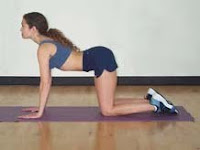Monday, May 7, 2012
Exercises for low back health
The following exercises have been chosen to spare the spine, enhance the muscle challenge and enhance the motor control system to ensure that spine stability is maintained in all other activities. Having stated this, they are only examples of well-designed exercises and may not be for everyone—the initial challenge may or may not be appropriate for every individual nor will the graded progression be the same for all clients. These are simply examples to challenge the muscles of the torso.
Cat-Camel (or Cow)
The routine should begin with the cat-camel motion exercise (spine flexion-extension cycles) to reduce spine viscosity (internal resistance and friction) and “floss” the nerve roots as they outlet at each lumbar
level. Note that the cat-camel is intended as a motion exercise—not a stretch—so the emphasis is on motion rather than “pushing” at the end ranges of flexion and extension. Repeat Five to eight cycles.
Curl-up
The cat-camel motion exercise is followed by anterior abdominal exercises, in this case the curl-up. The hands or a rolled towel are placed under the lumbar spine to preserve a neutral spine posture. Do not flatten the
back to the floor. Flattening the back flexes the lumbar spine, violates the neutral spine principle and increases the loads on the disc and ligaments. One knee is flexed but the other leg is straight to lock the pelvis-lumbar
spine and minimize the loss of a neutral lumbar posture. Alternate the bent leg (right to left) midway through the repetitions.
Birddog
The extensor program consists of leg extensions and the “birddog.” In general, these isometric holds should last no longer than seven to eight seconds given recent evidence from near infrared spectroscopy indicating
rapid loss of available oxygen in the torso muscles when contracting at these levels; short relaxation of the muscle restores oxygen. The evidence supports building endurance with increased repetitions rather than extending time.
Reference: "Enhancing Low-back Health through Stabilization Exercise", By Stuart M. McGill, Ph.D.,
Professor (Spine Biomechanics), University of Waterloo
Let's connect at info@gaiaadventures.com.
Catherine D'Aoust at GAIA Adventures, Kinesiologist, Workshops
www.gaiaadventures.com
Subscribe to:
Post Comments (Atom)




No comments:
Post a Comment